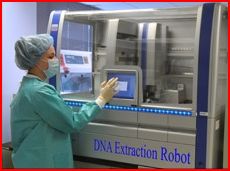We’re catching more crooks thanks to DNA. Not exactly an earth-shattering revelation, but it’s always nice to have some numbers.
The number of Texas crimes solved after a suspect’s DNA matched with offenders’ DNA samples stored in the national repository known as CODIS (Combined DNA Index System) recently passed the 10,000th mark.
The state averaged only about 200 matches a year during the first five years after the database was created in 1996. That number leaped to an average 1,000 hits a year for the next 10 years. In just the last 11 months, the number of matches has nearly doubled to 1,943, records show.
[…]
Harris County now processes an average of 400 cases a month, compared to about a dozen cases in the past, said the lab’s director, Dr. Roger Kahn, explaining how automation has replaced the tedious repetitive tasks once done by human hands.
The number of samples of offenders’ DNA stored in Texas’ database also has mushroomed to more than 660,000. Texas law requires all registered sex offenders, felons sent to prison or placed on community supervision, and juveniles committed to Texas’ juvenile justice system to submit a DNA specimen.
“The more samples in the pool, the greater opportunity for a match,” said Skylor Hearn, who oversees the crime lab that manages the state’s database. “There is a degree of recidivism in (the) criminal world, and we’re catching up to them.”
At the same time, the ability to make a match is increasing because DNA profiles can be developed from material that’s often invisible to the eye.
“Originally, we required a blood stain the size of quarter. Now it’s not visible. A dandruff flake is enough; just touching something leaves behind cells that can be enough. The systems are much more sensitive,” Kahn said.
Harris County also has a special “CSI-style” seven-member team that it can dispatch to collect potential DNA from sensitive murder scenes.
That last bit is somewhat of a commercial for the Harris County crime lab, which as you know is getting a new facility soon, but what the heck. Keep up the good work, y’all.
Using DNA analysis is often associated with innocence and exoneration these days, and for good reason. It’s important to remember that every time DNA absolves someone who had been convicted of a crime, it also points a finger at the real perpetrator. For every innocent person in jail, there is some number of guilty people who aren’t in jail. (Some may be in jail for other reasons, or they may be dead, or as with some questionable arson cases, there may have been no crime in the first place.) None of those exonerations, and subsequent arrests of the real criminals, would have been possible if the original DNA evidence had been destroyed upon conviction, as prosecutors like now-former Williamson County DA John Bradley have advocated. If he had gotten his way in the Michael Morton case, not only would Morton still be incarcerated, but a man who is now also suspected in the murder of at least one other woman would still be walking free. Think about that. And while you do, be sure to read Pam Colloff’s outstanding two-part story in the November and December editions of Texas Monthly about the Michael Morton saga. If you don’t have a tear in your eye, and a belly full of outrage, by the ending, you should consider talking to your doctor. See also Grits’ interview with Colloff for more.

